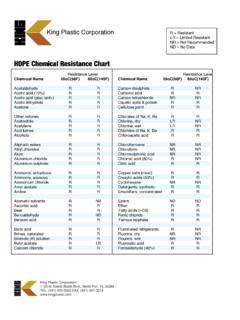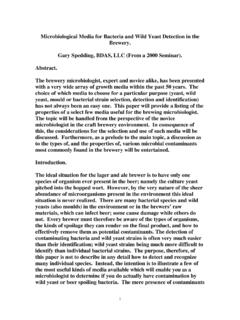Transcription of Calibration-Free Quantification of Lactic Acid and …
1 | 1 Author Oliver Palardy NatureWorks LLC 15305 Minnetonka Blvd Minnetonka, MN 55345 Charlie Spanjers and Andrew Jones Activated Research Company 7561 Corporate Way Eden Prairie, MN 55344 Abstract Quantification of compounds for which standards are not commercially available can involve costly synthesis of said compounds, or time-intensive approaches utilizing multiple analytical methods. Such a predicament is encountered when attempting to quantify the different Lactic acid oligomers present in aqueous Lactic acid solutions of a given total wt% Lactic acid . In this application note, a simple, Calibration-Free method for quantifying Lactic acid and its low molecular weight oligomers in an 88 wt% aqueous Lactic acid solution is described.
2 The data obtained with this method is compared with data obtained using other analytical methods. Introduction The most common detector for gas chromatography (GC) analyses of organic samples is the flame ionization detector (FID). Standard GC/FID analyses require calibrations for each analyte to be quantified because FID response is dependent on the chemical structure of the analyte. Often, standards are not commercially available or not easily synthesized and purified. For example, linear oligomers of Lactic acid , namely the dimer (Dp2), trimer (Dp3), and tetramer (Dp4), shown in Figure 1, are not commercially available and not readily synthesized and purified as pure compounds. H3 COOHCH3 OHOOn Figure 1. Lactic acid (n=0) and Lactic acid Oligomers (n=1,2,3).
3 It is well known that in concentrated aqueous solutions of Lactic acid (>30 wt%), the monomer will undergo self-condensation to produce an equilibrium mixture of monomer and Lactic acid The higher the wt% Lactic acid , the higher the concentration of oligomers produced, and the higher the molecular weight of oligomers possible. The relationship between actual wt% Lactic acid in a concentrated aqueous solution and the equilibrium oligomer distribution has been explored by Miller et al. using a combination of analytical methods, including titration, GC/FID/MS (after derivatization with silylation reagent), and HPLC/UV. The results obtained from this detailed study were used to create a thermodynamic model wherein a single parameter was proposed that accurately represents oligomer distribution and titratable acidity over the full range of Lactic acid concentrations.
4 2 Because commercial standards of Lactic acid oligomers are not available, the concentrations of such oligomers in concentrated aqueous Lactic acid solutions can be approximated using equilibrium data. This in turn allows for the generation of calibration curves when attempting to quantify such oligomers in a given sample, after derivatization with suitable silylation reagent, by GC/FID. Calibration-Free Quantification of Lactic acid and Lactic acid Oligomers in Concentrated Aqueous Lactic acid Solutions Using GC/Polyarc /FID with Deans Switch Application Note Quantifying Unique Compounds | 2 The Polyarc reactor is a catalytic microreactor that combines a catalytic combustion chamber, where all moles of carbon in eluting organic compounds are converted into a stoichiometric number of moles of carbon dioxide with > efficiency, which are subsequently converted to methane, again with > efficiency, in a catalytic reduction chamber prior to entry into FID.
5 Since the only carbon-containing molecule entering the FID is methane, the Polyarc reactor system alleviates the need to perform time-consuming calibrations by creating a uniform detector response for truly universal carbon This allows for Quantification of all carbonaceous compounds of interest in a sample containing an internal standard, of known concentration, in a single injection. In the following work, we apply this new capability to the Quantification of Lactic acid and Lactic acid oligomers in a concentrated aqueous Lactic acid solution without calibration. A comparison of results obtained using GC/Polyarc /FID with results obtained from other analytical methods is also provided. Experimental All GC/FID and GC/Polyarc /FID analyses were conducted on an Agilent 7890A GC/FID with a Zebron ZB-5HT (30 meter x mm ; m film thickness) or a J&W Scientific DB-5MS (30 meter x mm ; m film thickness) capillary column used for the separation.
6 The same GC method parameters were used with both setups. The high polarity and low volatility of Lactic acid oligomers adversely impacts the ability to analyze and accurately quantify these analytes directly by GC/FID. The Lactic acid monomer and linear Lactic acid dimer are amenable to GC/FID analysis, but the chromatographic efficiency is poor with significant peak tailing observed using capillary GC columns of widely varying stationary phase polarity for the separation. To enhance the volatility of the highly polar Lactic acid and Lactic acid oligomer analytes and improve the chromatographic efficiency of the separation, concentrated Lactic acid samples are first dissolved in acetonitrile and derivatized with N,O-bistrifluoroacetamide (BSTFA) with 1% trimethylchlorosilane (TMCS) at 50 C for 30 min.
7 BSTFA is a commonly used silylation reagent that converts all carboxylic acid and hydroxyl groups in a molecule, such as Lactic acid and Lactic acid oligomers, to corresponding trimethylsilyl (TMS) esters and ethers, respectively. A Deans switch (SGE Analytical Science, 123703) was used to divert excess BSTFA present in derivatized Lactic acid samples away from the Polyarc reactor during the analysis. Figure 2 shows the experimental setup used when analyzing BSTFA-derivatized Lactic acid samples, where the Deans switch was used to toggle column flow between FID and Polyarc /FID detection systems. Flow to the Polyarc /FID occurred only after the excess BSTFA had eluted from the column. A solenoid valve (Parker 30CU02LV4) was supplied with 4 psi of N2 and connected to the switch with a restrictor tube (Vici TSS107, m x mm ) placed between the two outlets.
8 Figure 2. Experimental Setup for Detection by FID or Polyarc /FID | 3 GC conditions Front inlet Carrier Gas Split/Splitless Hydrogen Inlet temperature 250 C Inlet pressure psi Septum purge flow 3 sccm Oven 50 C (2 min), 10 C/min to 150 C (0 min), 25 C/min to 320 C (2 min) Column ZB-5HT (30 m mm m) Syringe 10 L Injection volume 1 L FID conditions Temperature 335 C H2 5 sccm Air 350 sccm Makeup 45 sccm (N2) Sampling rate 50 Hz Polyarc reactor conditions Setpoint 293 C H2 35 sccm Air sccm Deans switch conditions Makeup 4 psi (N2) Restrictor Vici TSS107 ( m x mm ) Results and Discussion When quantifying the concentrations of Lactic acid and Lactic acid oligomers in concentrated aqueous solutions of Lactic acid by GC/FID, a very laborious calibration must be conducted after samples have been derivatized with BSTFA, because authentic standards of Dp2-Dp4 do not exist.
9 Actual calibration curves for Dp2-Dp4 are created based on the equilibrium concentrations of these oligomers in concentrated aqueous Lactic acid solutions ( , 88 wt%) evaluated internally by capillary electrophoresis. As shown in Figure 3, GC/Polyarc /FID analyses of BSTFA-derivatized concentrated aqueous Lactic acid solutions were characterized by extensive tailing of the residual, excess BSTFA peak, which provided a sloping baseline where the di(trimethylsilyl) derivative of Lactic acid elutes. Not only did this analyte peak elute on a sloping baseline but it also exhibited peak tailing, which contributes to inaccurate peak integration. Minimal tailing was observed for these peaks when analyzing the same sample by GC/FID.
10 It was hypothesized that residual BSTFA in the sample generates significant silicon dioxide on the combustion catalyst surface within the Polyarc that impacts combustion efficiency of later-eluting analytes, while also creating adsorption sites that contribute to the observed peak tailing. It was suggested by senior technical staff at ARC that a Deans switch device could be installed in series, prior to the Polyarc /FID, to resolve the issue with excess BSTFA. The primary application of the Deans switch is in multidimensional GC (MDGC).4 For our purposes, the Deans switch would be used to divert early-eluting excess, unreacted BSTFA reagent from entering the Polyarc reactor, so the performance of the Polyarc for later-eluting analytes of interest was not negatively impacted.









